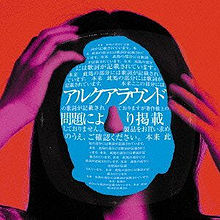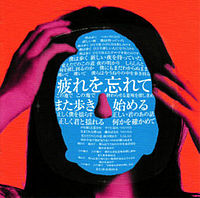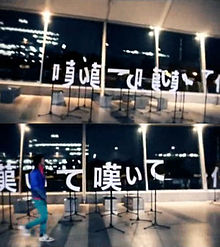- Aruku Around
-
"Aruku Around" 
Single by Sakanaction from the album Kikuuiki B-side "Spoon to Ase" Released January 6, 2010
(see release history)Format CD Single, digital download Genre J-pop, electropop, rock Length 4:26 Label Victor Entertainment Writer(s) Ichirō Yamaguchi Producer Sakanaction, Yuzuru Tomita Sakanaction singles chronology "Native Dancer"
(2009)"Aruku Around"
(2010)"Me ga Aku Aiiro"
(2010)Alternative covers  Limited edition cover
Limited edition cover Digital download cover
Digital download cover"Aruku Around" (アルクアラウンド A Walk Around) (pronounced "Aruku Araundo") is Japanese band Sakanaction's second physical single, released on released on January 13, 2010.[1] It was used in commercials for outdoor sports brand Kissmark from late December, 2009.[2]
Contents
Single
The physical single release features three main songs: the leading track, a B-side "Spoon to Ase," and a remix of the leading track from Shinshiro "Native Dancer" by Rei Harakami.[1] The limited edition of the single features a bonus track, ""Fish Alive Chapter 2" 1 Sequence by 3 Songs: Sakanaquarium 2009 @ Sapporo (Native Dancer, Sen to Rei, Adventure)." It is a sequel to the band's digital download live EP "Fish Alive" 20min., 1 Sequence by 6 Songs Sakanaquarium 2009 @ Sapporo, released in mid 2009.[3] The track features three more songs from the same live concert that the EP's live recordings originated from. The band vocalist's Ichirō Yamaguchi stated that he did not feel the release of the single was for purely commercial reasons to promote Kikuuiki, but instead that the band wanted to produce the product conceptually.[4]
The song was originally released as a digital download on the 6th of January as a single track, a week before the wide release. Recochoku had a monopoly on full-length cellphone downloads, and iTunes on PC downloads.[2]
Writing and inspiration
The song is an electronic rock song, inspired by 1980s dance music.[3] It was created by the band as a song that would appeal to a wide audience and to create a signature song for the band, that would sum up what the band was like to people who had not heard of Sakanaction before.[5][6] The song's title is a pun on the word aruku (to walk) which features heavily in the song's lyrics,[7] and the English phrase "A Look Around."[8][9][10]
The lyrics describe somebody walking alone somewhere, "waiting for a new night," and not understanding what they are searching for. The chorus makes the statement that everyone is currently "walking about in the undulation," and that we should forget our tiredness, search for the meaning that will end this, and to start walking again.[7] The lyrics were originally intended to be a series of haiku.[5] Yamaguchi felt that he had to write something autobiographic for the song's lyrics, as it did not feel right to have this type of song with something that was not based in reality.[4] He realised it had been a year and a half since the band had moved to Tokyo for their third album Shinshiro, and wrote about making the decision to consider Tokyo his home.[4] He considered "Aruku Around" a regular Sakanaction song, and described it as something "many people will find easy to get."[11] He considers "Aruku Around" to be the central axis to the album Kikuuiki,[4] and the lyrics the most important facet of the song.[4] Because of this, the lyrics are the central focus of both the single's cover artwork and the music video.[12]
The B-side "Spoon to Ase" was created as something resembling Sakanaction's folk/electro roots.[3] The lyrics describe the process of giving up smoking.[13] Despite this, the band originally did not have a guitar sound when the band were in Hokkaido, as was something made possible after they started to use Pro Tools software.[4] The song was created to specifically contrast with "Aruku Around"'s sound, and also created as a song that had an arrangement that contrasted with its lyrics.[4] Yamaguchi considers it his personal leading track to the single, as opposed to "Aruku Around."[4]
Cover artwork
The covers were made by design team Hatos, who have worked with Sakanaction since their second album Night Fishing.[4] The theme for the image thought up by the band members was "psychedelic in the style of Japanese literature," reminiscent of avant garde artist Shūji Terayama.[4] The cover depicts a psychedelically coloured woman with the song's lyrics instead of her face, reminiscent of 1980s pop-art.[14]
That the cover featured lyrics on the cover, this caused many copyright issues. Therefore, the versions shown online at official sites and music retailers feature a copyright notice apologising for the lack of lyrics, instead of the actual lyrics.[4] These versions were labelled as "dummy jackets."[14]
There were three different covers for the single: limited and regular edition covers, as well as a cover released exclusively with the digital download version of the single. The digital cover artwork was dubbed the "Mikaeri Bijin Ver." (見返り美人Ver. Changed View Beautiful Person Ver.) by the band,[2] and is the regular version of the jacket but seen at a different angle.[15]
Music video
The music video was shot by director Kazuaki Seki,[16] with artist visuals, organisation, production and styling by Hisashi "Momo" Kitazawa.[12] It was shot in a corridor at the Makuhari Messe in Tokyo, plus an outside terrace, using a Canon EOS 5D Mark II video camera.[17]
It features Yamaguchi walking with a constant camera shot.[12] He begins outside at nighttime, walking while eating an apple. He then pushes aside metal bars towards the camera that show some of the lyrics of the song. He then enters the Makuhari Messe corridor, and encounters different white symbols on sticks. These symbols are shown at different angles, and at one crucial point they merge together to create a phrase from the lyrics.[12] The crucial point is both when Yamaguchi walks past them in the video, and when the lyrics are sung in the song. Other than the different angle lyrics, several other ways, such as bassist Ami Kusakari holding up a flip book and a laptop showing a pre-recorded clip of Yamaguchi jumping in the hallway with the lyrics appearing, white symbols falling into a fish tank and lyrics scrolling over a conveyor belt. The video is interspersed with three brief scenes of band members performing on their instruments. The video ends with Yamaguchi walking outside to the terrace again, taking a bite of his apple.
After Seki realised the entire song was based around certain phrases in Japanese, he thought it would be a good music video to utilise the technique of having objects only comprehendable from one angle, something he had been interested in for a while.[17] Sakanaction members entrusted Seki with all of the decisions in the creative process, though added several ideas to the process themselves.[17] An initial idea was to have the entire lyrics on panels, however this was scrapped for practical reasons. Vocalist Ichirō Yamaguchi suggested the dark setting of the video.[17] Seki believed that for the one angle technique to have its full effect, the video had to be taken in one shot.[17]
The video was posted to Youtube on the official Victor Entertainment Youtube account in December, 2009.[12] As of June 2010, the video has been viewed over 1,410,000 times.[18] The video was chosen as the Space Shower network music video channel VMC's Video of the Month for January 2010, and was featured in the WOWOW music program Hits Seeker in January 2010.[12]
A special music video was created by Tokyo FM radio station School of Lock!. It features a succession of School of Lock! listener submitted cellphone recordings, as these people walk from one side of the screen to the other and do an activity.[19][20]
Chart ranking
On Oricon's physical single charts, song debuted at No. 3 in its first week, selling just over 13,000 copies.[21][22] It spent a further three weeks in the top 50,[22] and a further two more in the top 100.[22] In its time in the top 100 other than its first two weeks, it sold an average of 1,700 copies per week. The single spent a further five weeks between No. 100 and No. 200, selling a total of 27,000 copies in its total charting time of 11 weeks.[22]
On Billboard's Japan Hot 100 chart, the single peaked at No. 2 in January 2010.[23] It initially charted for two weeks in December 2010 at No. 67 and No. 45, based on airplay alone.[24] Closer to the single's release it began charting again, peaking at No. 6 based on solely airplay.[24] After a further week in the top 10 at No. 7, the single slowly fell down the charts, and stopped ranking in March 2010.[24] It received minor airplay again with the album's release.[24] The song's airplay was mirrored on Billboard's Adult Contemporary Airplay chart. It charted lowly once in December, followed with two more weeks in January, peaking at No. 9.[25][26] It charted for a total of five weeks.[25]
The song did not fare as well on the RIAJ's weekly full-length cellphone download chart. In its first week, it peaked at No. 38,[27] and charted between there and No. 50 for three further weeks, ending its run at No. 68.[28] After the album's release, the song charted for two further weeks, one at No. 56 and the other at No. 61.[28]
Critical reception
CDJournal gave the single its star of approval, reserved only for what they consider the most quality releases. They described the song as "A killer tune, where the pleasure of a moment and restraint live together."[29] Music critic Kenji Sasaki from Skream! thought positively of the song, saying that it "filled him with both pain and excitement." He praised the song for its blend of "soft electronica sound with '80s taste synths and an aggressive band sound," along with its "peculiar lyrics that reassuringly move you forward." He described Spoon to Ase as a song having a "strangely wonderful feeling" caused by the song's "acoustic sound and mysterious backing track." He thought Rei Harakami's remix of "Native Dancer" as being "beauty and weirdness screwed together, opposing each other together, but manage to blend with (vocalist) Yamaguchi's words." As a whole, he thought this single "maintained high definition with a balance of comprehensibility and manicness."[30]
Track listing
All songs written and composed by Ichirō Yamaguchi.
No. Title Arranger(s) Length 1. "Aruku Around" Sakanaction, Yuzuru Tomita 4:26 2. "Spoon to Ase" (スプーンと汗 "Spoon and Sweat") Sakanaction 3:19 3. "Native Dancer (Rei Harakami Heppoko Re-Arrange)" (ネイティブダンサー(rei harakami へっぽこre-arrange) "Rei Harakami's Amateur Re-Arrangement") Rei Harakami 6:13 4. ""Fish Alive Chapter 2" 1 Sequence by 3 Songs: Sakanaquarium 2009 @ Sapporo (Native Dancer, Sen to Rei, Adventure)" (ネイティブダンサー~セントレイ~アドベンチャー, limited edition bonus track) Sakanaction 14:12 Total length:28:10 Chart rankings
Chart Peak
positionBillboard Japan Hot 100[23] 4 Billboard Adult Contemporary Airplay[26] 9 Oricon daily singles[31] 2 Oricon weekly singles[21] 3 RIAJ Digital Track Chart Top 100[27] 38 Reported sales
Chart Amount Oricon physical sales[22] 27,000 Release history
Region Date Format Japan December 2, 2009[32] Ringtone January 6, 2010[2] Digital download January 13, 2010[2] CD single References
- ^ a b "サカナクション|アルクアラウンド|@Victor Entertainment" (in Japanese). Victor Entertainment. http://www.jvcmusic.co.jp/-/Discography/A020936/VICL-36553.html. Retrieved 2010-06-14.
- ^ a b c d e "kissmarkのCMでも話題のサカナクション「アルクアラウンド」、レコチョクにて着うたフル(R)独占先行配信!" (in Japanese). CDJournal. January 6, 2010. http://www.cdjournal.com/main/news/sakanaction/28352. Retrieved June 14, 2010.
- ^ a b c "サカナクション、1年ぶりの新曲リリース決定!" (in Japanese). Excite. 2009-10-26. http://www.excite.co.jp/music/news/story/66515/. Retrieved 2010-06-14.
- ^ a b c d e f g h i j k "サカナクション 『アルクアラウンド』" (in Japanese). Hot Express. 2010-01-13. http://www.hotexpress.co.jp/interview/100113_sakanaction/index.html. Retrieved 2010-06-21.
- ^ a b "サカナクション インタビュー - プレイリストから新たな音楽を発見する[MUSICSHELF]" (in Japanese). Music Shelf. 2010-01-08. http://musicshelf.jp/?mode=static&html=series_b115/index. Retrieved 2010-06-21.
- ^ "2010年代を貫く名盤「kikUUiki」誕生" (in Japanese). Natalie. 2010-03-17. http://natalie.mu/music/pp/sakanaction02. Retrieved 2010-06-21.
- ^ a b "アルクアラウンド サカナクション 歌詞情報 - goo 音楽" (in Japanese). Goo Ongaku. http://music.goo.ne.jp/lyric/LYRUTND87470/index.html. Retrieved 2010-05-20.
- ^ "A Look Around 新色Tシャツのお知らせ" (in Japanese). Hip Land Music Corporation. 2010-02-02. http://sakanaction.jp/news/archives_5.html. Retrieved 2010-06-14.
- ^ "A Look Around" (in Japanese). Hip Land Music Corporation. http://sakanaction.jp/news/images/AlookAround_J.jpg. Retrieved 2010-06-14.
- ^ "A look around!" (in Japanese). 岩寺基晴. 2010-01-13. http://sakanaction.jp/blog/entry/2010/01/a-look-around.html. Retrieved 2010-06-14.
- ^ "サカナクション『「アルクアラウンド」の先、これまでの集大成となるアルバムが完成』" (in Japanese). Oricon Style. 2010-03-17. http://www.oricon.co.jp/music/interview/2010/sakanaction0317/index.html. Retrieved 2010-06-14.
- ^ a b c d e f "サカナクション「アルクアラウンド」ミュージック・ビデオ公開!" (in Japanese). CDJournal. 2009-12-28. http://www.cdjournal.com/main/news/sakanaction/28290. Retrieved 2010-06-20.
- ^ "スプーンと汗 サカナクション 歌詞情報 - goo 音楽" (in Japanese). Goo Ongaku. http://music.goo.ne.jp/lyric/LYRUTND87767/index.html. Retrieved 2010-05-20.
- ^ a b "サカナクション新曲ジャケットは発売日までのお楽しみ" (in Japanese). Natalie. November 20, 2009. http://natalie.mu/music/news/24107. Retrieved June 21, 2010.
- ^ "サカナクション「アルクアラウンド」、デジタル配信開始" (in Japanese). Barks. January 7, 2010. http://www.barks.jp/news/?id=1000057084. Retrieved June 14, 2010.
- ^ "サカナクション 楽曲名 アルクアラウンド" (in Japanese). Space Shower. http://www.spaceshowertv.com/search/detail.cgi?mu=0078097&ch=0. Retrieved 2010-06-14.
- ^ a b c d e "サカナクションからPerfumeまで。映像作家、関和亮の演出術" (in Japanese). White-Screen. 2010-03-31. http://white-screen.jp/2010/03/kazuakiseki.php. Retrieved 2010-06-14.
- ^ "サカナクション/アルクアラウンド" (in Japanese). Victor Entertainment. Youtube. 2010-03-31. http://www.youtube.com/watch?v=vS6wzjpCvec. Retrieved 2010-06-14.
- ^ "SCHOOL OF LOCK! 「アルクPVプロジェクト」" (in Japanese). Hip Land Music Corporation. 2010-03-18. http://sakanaction.jp/news/archives_3.html. Retrieved 2010-06-14.
- ^ "アルクアラウンド~サカナクション×SCHOOL OF LOCK! Ver.~" (in Japanese). School of Lock!. Youtube. http://www.youtube.com/watch?v=S4yiDSYdO2c. Retrieved 2010-06-14.
- ^ a b "アルクアラウンド(初回限定盤) - サカナクション / オリコンランキング情報サービス「you大樹」" (in Japanese). Oricon. http://ranking.oricon.co.jp/free_contents/search/detail.asp?itemcd=848213&samecd=1. Retrieved June 13, 2010.
- ^ a b c d e "オリコンランキング情報サービス「you大樹」". Oricon. http://ranking.oricon.co.jp. Retrieved 2010-06-12. (subscription only)
- ^ a b "Japan Billboard Hot 100". Billboard Japan. January 25, 2010. Archived from the original on June 14, 2010. http://www.webcitation.org/5qSL03b6n. Retrieved June 14, 2010.
- ^ a b c d "Hot 100|JAPAN Charts|Billboard JAPAN" (in Japanese). Billboard. http://www.billboard-japan.com/system/jp_charts/hot100/. Retrieved 2010-06-14.
- ^ a b "Japan Billboard Adult Contemporary Airplay". Billboard Japan. http://www.billboard-japan.com/system/jp_charts/adult_airplay/. Retrieved June 14, 2010.
- ^ a b "Japan Billboard Adult Contemporary Airplay". Billboard Japan. January 25, 2010. Archived from the original on June 14, 2010. http://www.webcitation.org/5qSL64keb. Retrieved June 14, 2010.
- ^ a b "RIAJ Digital Track Chart: Chart issue January 12, 2010" (in Japanese). Recording Industry Association of Japan. January 15, 2010. http://satsuki.musicdb.gr.jp/all_info/ranking_weekly/WeeklyRankingAction.do?term=2010f&weeklyCd=20100112&rankKbn=50. Retrieved June 14, 2010.
- ^ a b "有料音楽配信チャート" (in Japanese). RIAJ. http://www.riaj.or.jp/data/others/weekly_chart/index.html. Retrieved 2010-06-14.
- ^ "サカナクション / アルクアラウンド [CD] [シングル]" (in Japanese). CDJournal. http://artist.cdjournal.com/d/-/4109101171. Retrieved 2010-06-14.
- ^ "サカナクション / アルクアラウンド" (in Japanese). Kenji Sasaki. Skream!. http://skream.jp/diskreview/2010/01/post_22.php. Retrieved 2010-06-14.
- ^ "赤西仁・LANDS、映画発キャラクター13年4ヶ月ぶりの首位" (in Japanese). Oricon. January 19, 2010. http://www.oricon.co.jp/news/rankmusic/72568/full/. Retrieved June 13, 2010.
- ^ "サカナクション新曲がスノボブランドとタイアップ". Natalie. 2009-12-02. http://natalie.mu/music/news/24618. Retrieved 2010-06-21. (subscription only)
External links
- Victor "Aruku Around" profile (Japanese)
Categories:- Sakanaction songs
- 2010 singles
- Japanese-language songs
Wikimedia Foundation. 2010.


